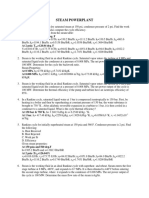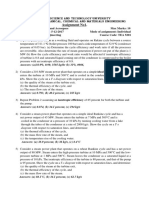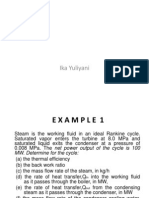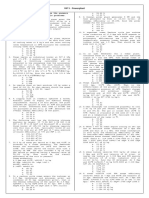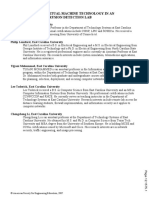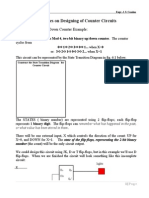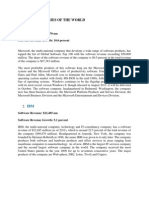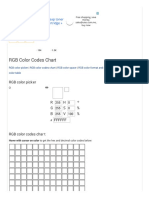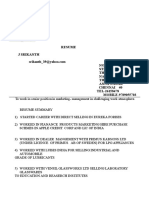DEPARTMENT OF MECHANICAL ENGINEERING
Indian Institute of Technology Madras
MESlZg - trinciplep of Thernl4t Enqfev Co$Lersion
November 5,2019
Tutorial
1. Water is the working fluid in a vapor power cycle with superheat and reheat. Superheated vapor enters the first turbine stage
at 8 MPa and 480'C and expands to 0.7 MPa. Then, it is reheated to 480'C before entering the second turbine stage, where it
expands to the condenser pressure of 8 kPa. The mass flow rate of steam entering the first turbine stage is 2.$ ;105 kghr.
Each turbine stage operates with an isentropic etficiency of 88%. The pump operates with an efficiency of 80%. Determine
for the cycle (a) the net power output, in kW (b) the thermal efficiency (c) the rate ofheat transfer to iooling water passing
through the condenser, in kW.
2. Steam at 10 MPa, 600oC enters the first-stage turbine of a Rankine cycle with reheat. Steam enters the second stage turbine
after being reheated to 500"C. Saturated vapor exits the second-stage turbine. The condenser pressure is 6 kpa. Each turbine
stage operates with an isentropic efficiency of 85%. All other aspects of the operation follow the ideal cycle. Determine the
cycle thermal effi ciency.
3. The Figure 1. Shows a vapor power cycle with reheat and
regeneration. The steam generator produces vapor at 6.9 Mpq
430'C. Some of this steam expands through the first turbine
stage to 690 kPa and the remainder is directed to the.heat
exchanger. The steam exiting the first turbine stage enters the
flash chamber. Saturated vapor and saturated liquid at 690 kpa
exit the flash chamber as separate streams. The vapor is
reheated in the heat exchanger to 277"C before entering the
second turbine stage. The open feedwater heater operates at
690 kPa, and the condenser pressure is 6.9 kPa. Each turbine
stage has an isentropic efficiency of 88% and the pumps
operate isentropically. For a net power output of 5.27 x l0 e
kJ/l,r. Determine: (a) the mass flow rate through the steam
generator, in kg/hr (b) the thermal efficiency of the cycle (c)
the rate of heat transfer to the cooling water passing through
the condenser. in kJ/hr. Figure 1. Vapor power cycle
T
In modern steam power plant, it is common practice to use supercritical pressure in the boiler. Calculate the net work, heat
added, efficiency and work ratio of an internally reversible double reheat 225/539/550/560 cycle. Reheats occurs at 60 and
20bar. Condensing is at 0.07 bar. Calculate the thermal efficiency of the cycle. What power output may be obtained with a
flow rate of550,000 kg/h.
5. Consider a cogeneration plant, the steam enters the turbine at TMPa and 500oC. Some steam is extracted from the turbine at
500kPa for process heating. The remaining steam continues to expand to 5kPa. Steam is then condensed at constant pressure
and pumped to the boiler pressure of 7MPa. At times of high demand for process heat , some steam leaving the |oiler is
throttled to 500kPa and is routed to the process heater. The extraction fractions are adjusted so that steam leaves the process
heater as a saturated liquid at 500kPa. It is subsequently pumped to 7MPa. The mass flow rate of steam through the boiler is
l5kg/s. Disregarding any pressure drops and heat losses in the piping, and assuming the turbine and the pump to be
isentropic, determine (a) the maximum rate at whioh process heat can be supplied (b) the power produced and the utilization
factor when no process heat is supplied, and (c ) the rate ofprocess heat supply when 10% ofthe steam is extracted before it
enters the turbine and70o/o ofthe steam is extracted from the turbine at 500kPa for process heating.
6. A binary system power plant uses mercury for the high-temperature cycle and water for the low-temperature cycle. The
temperatures and pressures are shown in Figure 2. The maximum temperature in the steam cycle is where the steam leaves
the superheater at point 4 where it is 500'C. Determine (a) the ratio of the mass flow rate of mercury to the mass flow rate of
water in the heat exchanger that condenses mercury and boils the water (b) the thermal efficiency of this ideal cycle. The
following saturation properties for mercury are known:
P, MPa Tr, oC hr, kJ/kg hg, kJ/kg sr, kJ/kgK sg, kJ/kgK
0.04 309 42.21 335.64 0. I 034 0.6073
r.60 562 75.37 364.04 0.1 498 0.4954
7' The power plant shown in Figure 3 combines a gas-turbine cycle and a steam-turbine cycle. The following data are known
for the gas-turbine cycle. Air enters the compressor at 100 kPa,25"C,the compressor pressure ratio is 14,;d the isentropic
compressor efficiency is 87oh; the heater input rate is 60 MW; the turbine inlet temperature is 1250.C, the exhaust pr.gur.
� is 100 kPa, and the isent
rhe rorowinfil#'il:ff Hlttr;:H:l:il,l,Xtt#;ji'rlm;,TUttemperature rrom rhe heat exchanger is 200.c.
ff.T,',H:#.f;lY,';;t:i,.ff:*lZZnn**.ry.i*., r'-sit",i".b'i::!i;L:,3Jl,i:'il',ilq t;;;.1; kPa,1ie
the steam .r"l; a.ft;';,lerau
thermal efficiency
,'" u"'-*.uine cvcre i;t;; ;j:;?#iJl'"fn,:7";
"rTJ;1'.lj.1X'
I
l
;^"
(+-'
Fig' 2' Mercury/water binary power
system Fig. 3. combined Brayton/Rankine
cycle power system
8'
fl*:HJ:i:,ff;f,T tnttutor o-perates at 160bars. 1260kg/s of water goes down rhe downcom
The er, 7.32oc subcoored.
rosses in,n.o"*;il;#;#'.i:# ijfj ffi::;Tf:,1:T;1T,Hf,Jf;r.,.;H:X,l".J:ffii#nlijr.*nH;
efficiency is 0.70.
9 ' A l5m long' 75mm- diameter steam generator water tube receives saturated water
at a velocity of 0.7mls and a pressure
i.::,f;,y;::ll:i::Sfi.t unirormri. it'. 'rip
."tio i,-r.s. c;r.,j*,the maximum r.,"ui uio"o to the
tube,
of
irthe exit void
10' Steam enters a convective-type
superheater saturated at 160bars.
transfer coeffiuients inside hi and At.a given load it leaves at 4g0 oc. The
outside ho of the tuu., u."1.op".,r"";r convection
are the mass flow rates of steam ,",n,',"d*j ,r;;, i.rp..tiu"ly. where m, andheat
and tur. rina ,rr. .rit g", ;;il;** m,
temperature Tg remains constant "zooo ir uotrr steam unj gu, flow are doubled.
proportional to U(Tg-Ts), where
ut "c. ;:;""f*'rt"fii"ity tr,ui l*";;;;rf;&
The gas
,"r*""n gas and steam is
Ts is the average of the exit
ij;; steam temperature.
""J
l1' Dry saturated steam enters a radiant superheater
proportional to m"08' where m" at 160bar. The convective heat-transfer coefficient
inside the
is the steam flow rate. rrr.i"oi"i,*
surface is proportional to (T1a- r*ol, i.ut trunrf.,. between the combustion gases and tubes is
*rt"t" rr and T* ar" ttr" flame aig ,r?. *1li the tube
;il;u.Jr]."rp..tiuely. At a given road,
lf:;:11*ffi:,Xx.J'iJ:[fi:1ffi;;;:l*":: *;i:'3.,#:i[lecring the."";;;,;;sistance orirre wari ca,cu,ate
12' A power plant is situated at sea level'1650kg^.of
flue gases enter a 5-m diameter stack
outside air temperature is at 10oc' at 140.c and leaves at 110"c. rhe
The sta&
"rr.ightis c.rig,riJ roiu;;;g pressure
correlation, carculate the flue gur pru-" of 0.007bar. Using the carson and M.ses
if the prevailing wirids are at 80kmoh.
t'
*,1'o,hI3irtiJ3:;ffi;'il::tffi;H:::l "i#r':i ;^e
riser receivers unirorm hear nux
and saturared water. rhe
14' A 250 m-height 4-m-diameter stack
emits 2 ton/s of 100 "c gases into.5oc air. r'he prevailing
wind velocity is 50km/h.
,Tff;X*Hi;i:i;*t,I..i:':l::i:,':,.J',ffi."[,*l"fffii,,f];;;ffiff:il"h,.,:_0 0,Kd iti,.",.ry
l5' Consider a steam powerplant operating
on simple ideal
is condensed in the conden"t ut pt;t;;;i?;kp". Rankine cycle. The steam enters the turbine at 3Mpa and 350"c and
u il;.t"r"."#"io.u..ribility of the Runkin. cycre (a, four
tr1"li?"Ji)d::1f,'-lfTni.;*n",'f::**n*i;*',ffd,.i;;f"#at processes
is rejecied,",r,i.o"ii"e





